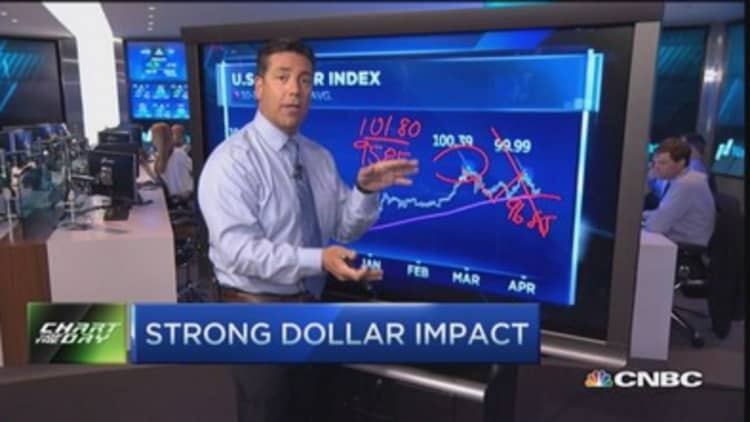With volatility rampant, valuations frothy and economic headwinds on the horizon, it may be time to ratchet back exposure to small-cap stocks—at least over the short term. Or not, depending on whom you ask.
While market strategists generally agree that small-cap indices are trading at a premium relative to their large-cap peers, opinions diverge over how the sector is likely to perform in the months ahead.
Some, including Steven DeSanctis, head of small-cap strategy for Bank of America Merrill Lynch, suggest investors should underweight small caps for at least the second quarter.
"Valuations are back to levels we don't feel comfortable with," he wrote in his April monthly sector report.
Although performance has been "decent" so far this year, said DeSanctis, with the benchmark Russell 2000 index of U.S. small caps reaching a record high on April 15, the index currently trades at an estimated price-to-earnings ratio of 18.9, which is higher than the historic norm. "But when we use a more realistic earnings growth of 7 percent, the measure moves above 19. This places the size segment very close to our danger zone, which tends to bode poorly for subsequent performance."
Francisco Torralba, a senior economist for mutual fund tracker Morningstar, shares DeSanctis' concern.
"From a valuation standpoint, the position of our team is that U.S. small-cap stocks are less attractive by our preferred valuation metrics than large caps," he said.
Read MoreA retirement stress 50 million+ workers are facing
Investors seem to agree. Small-cap funds posted net outflows of $2.3 billion during the first quarter, according to Morningstar.
Also troubling for the small-cap sector, said Torralba, is the likelihood that the Fed will begin raising interest rates (albeit slowly) later this year.
Small caps, which consist of companies with a market capitalization of between $300 million and $2 billion, have higher debt obligations at present than large-cap stocks, making them far more vulnerable to future rate hikes.

"Small caps have more leverage, and that's a problem because over the medium-term, we expect interest rates to go up, so costs will rise more for small caps," he said. "We are wary of the large level of debt on the small-cap balance sheet."
And then there's the matter of volatility. Indeed, the sector has been anything but boring over the last two years.
After an impressive 40 percent gain in 2013, the Russell 2000 index underperformed its large-cap counterpart, the Russell 1000, by a wide margin for most of 2014, plunging into negative territory on a year-over-year basis last October.
The sector then staged a comeback, reversing its losses and posting a 4.9 percent total return for all of 2014 against the large-cap index's gain of 13.2 percent.
Year to date, the small-cap index is up 3.5 percent, hitting its all-time high of 1,275.35 on April 15, compared with the S&P 500's gain of just over 2.3 percent through April 30.
Read MoreInvestors flock to this unlikely $11B yield haven
Manic mood swings are par for the course where small caps are concerned, primarily because the sector consists of young companies with significant growth potential but a higher probability of failure. Current volatility, however, has outpaced the average, and DeSanctis said he expects the pattern to continue.
Volatility is running above last year's level, he said, adding, "We think it will continue due to the uncertainty around Fed hikes and no QE [quantitative easing] backstop."
We think small caps have benefited as the dollar strengthens significantly against other major currencies, and we think that should continue.Chris Retzlermanager, Needham Growth Fund
But not everyone is ready to underweight the sector just yet.
"We're bullish on small- and mid-caps," said David Lefkowitz, senior equity strategist for UBS Wealth Management Research.
While absolute valuations admittedly err on the high side, that metric is higher than average for large-cap stocks right now, too, he said, noting relative valuations, which compare a stock's price-to-earnings ratio with other companies, are less worrisome.
The forward price-to-earnings ratio for the Russell 2000, which uses forecasted earnings for the next 12-months, currently stands at 19, an 8 percent premium over large caps.
"If you look over the long term since the late 1970s, the small-cap index on average trades at a 7 percent premium relative to large caps, so it's essentially exactly in line with its long-term average," said Lefkowitz, adding the same is true of its price-to-book ratio. "The broad valuation signals we're getting are neutral and are not signaling any concern."
He said, too, it's important to consider the factors that drive valuation, including inflation, interest-rate activity and growth outlook: "We have very low inflation, interest rates that are still historically low and prospects for continued growth."
Read MoreHow the little guy can profit from merger mania
The fact that interest rates are expected to rise starting later this year does not necessarily trigger any alarms, either, at least over the next 12 to 18 months, said Lefkowitz.
"We looked at 11 tightening cycles since the 1950s, and typically stocks perform fine in the 12 months after the first Fed rate hike," he said.
Beyond that, there are several positive trends emerging that could change the story for the small cap sector, said Chris Retzler, manager of the Needham Growth Fund. Namely, the dramatic strengthening of the dollar over the last nine months.
Small caps consist largely of U.S.-based companies that derive the majority of their sales and profit from domestic consumers. Thus, they are more insulated from currency changes than larger, multinational firms that do business abroad.
"We think small caps have benefited as the dollar strengthens significantly against other major currencies, and we think that should continue," said Retzler. "We are not reducing our exposure to small caps."
Merger and acquisition activity has also been solid for the first quarter of 2015—especially for health-care, financial and technology companies—which tends to buoy small-cap stocks, and Retzler believes the sector is positioned to continue its expansion through the rest of the year. "I think the second-half numbers will look better," he said.
In a mixed-message environment, then, what's an investor to do? That depends on your time horizon.
For tactical investors, DeSanctis favors growth over value stocks, including industrials and information technology, which have the potential for higher earnings over the short term.
He also maintains a bias toward cyclical over secular and defensive stocks for the remainder of 2015 as the U.S. and global economic recovery matures. Cyclical stocks, which are those most highly correlated with economic activity, have historically outperformed in the years immediately following an economic recovery.
"We are sticking with our cyclical bias, as a better economy should boost earnings growth across most sectors," DeSanctis writes, noting larger-cap shares are also likely to outperform as volatility triggers a flight to quality. "With the weaker performance in 2014, the cyclical stocks look more attractive on a valuation basis."
Diversification plays
Active investors may also be able to beat the benchmark by diversifying within the small-cap sector, particularly into international stocks, said Torralba.
"Generally speaking, European and Japanese stocks are more attractively priced than U.S. stocks, so diversifying into one of those two geographic areas could improve your risk-adjusted return," he said.
A small number of passively managed funds offer diversification benefits and low expense ratios.
The Vanguard FTSE All-World ex-US Small-Cap ETF (VSS), for example, tracks 3,300 small-cap companies from both developed and emerging markets and is among the most diversified small-cap international equity funds, according to Morningstar.
iShares MSCI EAFE Small-Cap ETF (SCZ), the most liquid option in its class, also tracks companies from developed Europe and Asia but does not hold small caps from Canada or any emerging-markets country.
According to Torralba, active investors should specifically avoid energy stocks in the months ahead. "In general, the energy sector is probably going to experience difficulties repaying debt over the next three to six months due to the decrease in oil and natural gas prices," he said.
Long-term investors get a different directive: Forget all the noise, and keep your allocation on course.
Despite their volatility, said Retzler, small-cap stocks deliver important diversification benefits and significant growth potential.
"Long-term investors should stay the course and not attempt to market time," said Retzler. "Small-cap companies historically deliver higher returns, and they generally reward stock pickers."
Indeed, the small-cap Russell 2000 has outperformed the broader market in 23 of the last 36 years, according to the Stock Trader's Almanac.
A hypothetical $1,000 investment in Russell 2000 at the start of 1979 was worth $29,742 at the end of 2014, a 2,874 percent gain. The same investment in was worth $21,468, a 2,047 percent gain.
With economic winds blowing in from both directions, the outlook for small-cap stocks for the next few quarters remains unclear.
Their ability to balance the equity portion of one's portfolio, however, is not.
"Investors should maintain some exposure to small caps to take advantage of diversification," said Torralba.
—By Shelly Schwartz, special to CNBC.com



